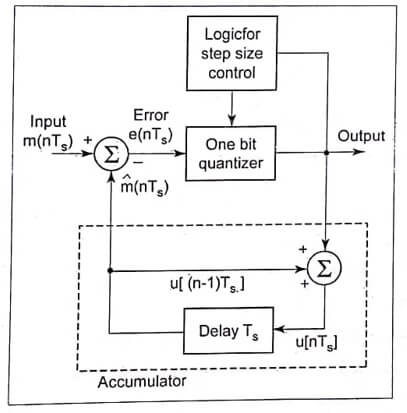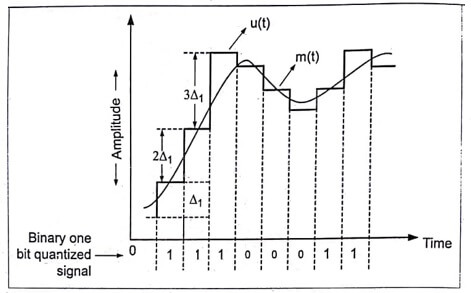Why ADM?
The performance of delta modulator can be improved significantly by making the step size of the modulator as a time-varying form i.e., the step size of the modulator is increased, when the input is varying rapidly and the step size of the modulator is decreased, when the input is varying slowly. Then, the system which uses the above technique for reducing the quantization errors is called Adaptive Delta Modulation (ADM) system.
ADM System
(i) ADM Transmitter

Fig.1. ADM transmitter
- In ADM transmitter “logic for step control” is the only additional block. The remaining blocks are same as that of linear DM transmitter.
- Depending on the output of one bit quantizer, the step size is increased or decreased according to a specified logic.
Consider this example,
(i) For the next sample, step size may be doubled, when the one bit quantizer output is high (i.e., ‘1’).
(ii) For the next sample, step size may be reduced by one step, when the one bit quantizer output is low (i.e., ‘0’)

Fig. 2. Waveforms of ADM
(ii). ADM Receiver
The entire operation of receiver is divided into two parts. In the first stage, for each incoming bit step size is produced. The step size is decided by both previous and present inputs.
Then it is applied to the accumulator, whose function is to generate staircase waveform depending on the input applied to it.

Fig .3. ADM transmitter
Finally, the original message signal is reconstructed from the staircase waveform using low pass filter, which allows only the maximum frequency of the message signal remaining high frequency will be attenuated.
ADVANTAGES OF Adaptive Delta Modulation
The advantages of ADM over DM are as follows:
- The signal to noise ratio is better than ordinary delta modulation because of reduction in slope overload distortion and granular noise.
- Wide dynamic range due to variable step size.
- Better utilization of bandwidth as compared to delta modulation.
- Simplicity of implementation of transmitter and receiver.
- Low signaling rate.
| Read More Topics |
| Comparison of digital pulse modulation systems |
| Microprocessor controlled temperature system |
| Primary sources of electric power |





